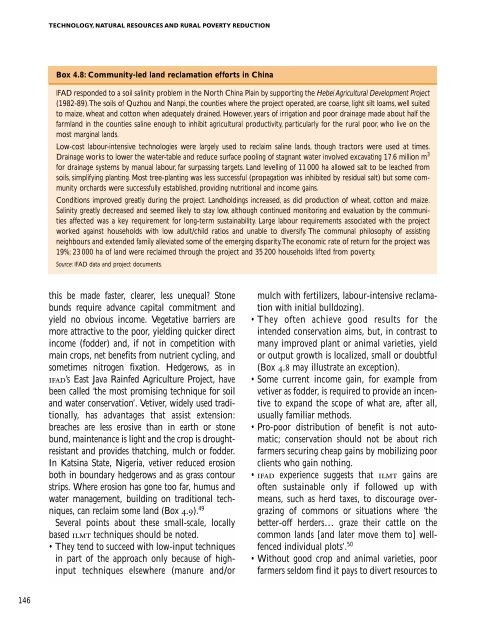English - IFAD
English - IFAD
English - IFAD
You also want an ePaper? Increase the reach of your titles
YUMPU automatically turns print PDFs into web optimized ePapers that Google loves.
TECHNOLOGY, NATURAL RESOURCES AND RURAL POVERTY REDUCTION<br />
Box 4.8: Community-led land reclamation efforts in China<br />
<strong>IFAD</strong> responded to a soil salinity problem in the North China Plain by supporting the Hebei Agricultural Development Project<br />
(1982-89).The soils of Quzhou and Nanpi, the counties where the project operated, are coarse, light silt loams, well suited<br />
to maize, wheat and cotton when adequately drained. However, years of irrigation and poor drainage made about half the<br />
farmland in the counties saline enough to inhibit agricultural productivity, particularly for the rural poor, who live on the<br />
most marginal lands.<br />
Low-cost labour-intensive technologies were largely used to reclaim saline lands, though tractors were used at times.<br />
Drainage works to lower the water-table and reduce surface pooling of stagnant water involved excavating 17.6 million m 3<br />
for drainage systems by manual labour, far surpassing targets. Land levelling of 11 000 ha allowed salt to be leached from<br />
soils, simplifying planting. Most tree-planting was less successful (propagation was inhibited by residual salt) but some community<br />
orchards were successfully established, providing nutritional and income gains.<br />
Conditions improved greatly during the project. Landholdings increased, as did production of wheat, cotton and maize.<br />
Salinity greatly decreased and seemed likely to stay low, although continued monitoring and evaluation by the communities<br />
affected was a key requirement for long-term sustainability. Large labour requirements associated with the project<br />
worked against households with low adult/child ratios and unable to diversify. The communal philosophy of assisting<br />
neighbours and extended family alleviated some of the emerging disparity.The economic rate of return for the project was<br />
19%; 23 000 ha of land were reclaimed through the project and 35 200 households lifted from poverty.<br />
Source: <strong>IFAD</strong> data and project documents.<br />
this be made faster, clearer, less unequal? Stone<br />
bunds require advance capital commitment and<br />
yield no obvious income. Vegetative barriers are<br />
more attractive to the poor, yielding quicker direct<br />
income (fodder) and, if not in competition with<br />
main crops, net benefits from nutrient cycling, and<br />
sometimes nitrogen fixation. Hedgerows, as in<br />
<strong>IFAD</strong>’s East Java Rainfed Agriculture Project, have<br />
been called ‘the most promising technique for soil<br />
and water conservation’. Vetiver, widely used traditionally,<br />
has advantages that assist extension:<br />
breaches are less erosive than in earth or stone<br />
bund, maintenance is light and the crop is droughtresistant<br />
and provides thatching, mulch or fodder.<br />
In Katsina State, Nigeria, vetiver reduced erosion<br />
both in boundary hedgerows and as grass contour<br />
strips. Where erosion has gone too far, humus and<br />
water management, building on traditional techniques,<br />
can reclaim some land (Box 4.9). 49<br />
Several points about these small-scale, locally<br />
based ILMT techniques should be noted.<br />
• They tend to succeed with low-input techniques<br />
in part of the approach only because of highinput<br />
techniques elsewhere (manure and/or<br />
mulch with fertilizers, labour-intensive reclamation<br />
with initial bulldozing).<br />
• They often achieve good results for the<br />
intended conservation aims, but, in contrast to<br />
many improved plant or animal varieties, yield<br />
or output growth is localized, small or doubtful<br />
(Box 4.8 may illustrate an exception).<br />
• Some current income gain, for example from<br />
vetiver as fodder, is required to provide an incentive<br />
to expand the scope of what are, after all,<br />
usually familiar methods.<br />
• Pro-poor distribution of benefit is not automatic;<br />
conservation should not be about rich<br />
farmers securing cheap gains by mobilizing poor<br />
clients who gain nothing.<br />
• <strong>IFAD</strong> experience suggests that ILMT gains are<br />
often sustainable only if followed up with<br />
means, such as herd taxes, to discourage overgrazing<br />
of commons or situations where ‘the<br />
better-off herders… graze their cattle on the<br />
common lands [and later move them to] wellfenced<br />
individual plots’. 50<br />
• Without good crop and animal varieties, poor<br />
farmers seldom find it pays to divert resources to<br />
146
















